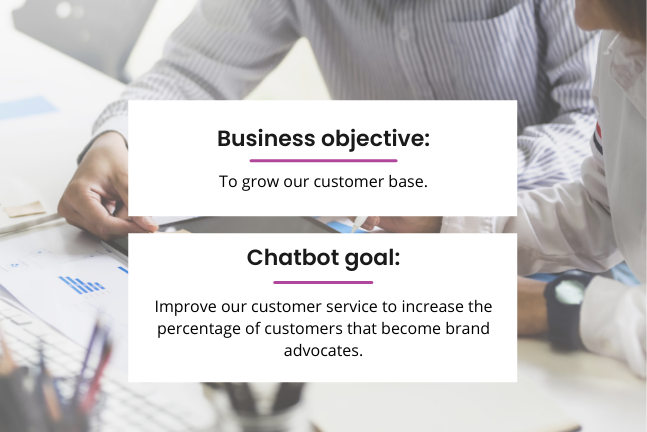Goal Setting for Chatbots: A Complete Guide

Every chatbot must have a goal. If not, how would you prove their efficiency? How would you justify a business investing their precious capital into developing or improving it?
As a chatbot developer, part of your job is to define these goals. Thankfully, it doesn't have to be a difficult task.
In this guide, we cover goal setting for chatbots from A to Z.
What are chatbot goals?
A chatbot goal is a specific, measurable, aspirational, realistic, and time-bound metric that drives every aspect of a chatbot.
Why is goal setting important for a chatbot?
In their interview, ubisend partners Jim Rowe-bot revealed the goal they had for their very first chatbot: to reduce the cost of managing customer conversations by 25% within 12 weeks of going live. They managed to smash this target in four weeks (read the complete interview).
While setting a goal wasn't the only reason behind this incredible success, it certainly helped.
Writing goals down helps you define a clear path for your chatbot, from scoping to success. Goal setting is about clarity.
- Clarity of why you are building this bot.
- Clarity of who you are building this bot for.
- Clarity of what matters in this bot.
- Clarity of the metrics you should track.
- Clarity of the deployment phases you should schedule.
Without clear goals, you are building a chatbot in the dark and hoping for the best. That's not a great way to get results (and paid).

Remember: chatbots are iterative by nature. Goal setting helps you and your client see the value in what you're building (e.g. 'this chatbot will help us reduce customer service enquiries by 46%'). It will also help you course-correct between iterations to ensure you are reaching this goal.
Need more than that? Dr. Gail Matthews ran a study on goal setting and found that people writing goals down are 42% more likely to achieve them (source).
If on top of everything, setting goals might actually help you achieve them, it's certainly worth a try.
Aligning chatbot goals with business objectives
Before we dive into the actual creation of goals, it's important to cover business objectives.
Business objectives are the overarching targets the business is aiming to achieve. These supersede the entire company. They are success factors the board (or management team) will measure the company's performance against.
It is clear the chatbot you build will be part of the business. Therefore, it is logical to ensure the goals you define for your chatbot align with the business' objectives.

For example, if the business objective is to reach new customers, the goals of a customer service chatbot might have to be to delight customers and encourage them to talk about the products with friends and family.
When selecting goals, select some that move the needle with impactful results in an area of focus for the business.
How to create chatbot goals?
Now that you're convinced that goals are good for everyone involved, let's explore how to create chatbot goals.
There are three frameworks we will cover below which, once combined, will help you create the best (and reachable) goals.
1. The question framework
The question framework is a fantastic first step to defining a chatbot's goal(s). Ask yourself, and your client, the following questions:
- What is the chatbot's purpose?
- Why is this its purpose?
- What is currently being used instead of the chatbot?
- Why is that not working?
- How would a chatbot do things better?
In just five simple questions, you've instantly framed the entire project.
Here's an example of this first step in action.
- What is the chatbot’s purpose?
- Help our small customer service team deal with the massive influx of tickets during peak season.
- Why is this its purpose?
- Our team can't keep up and it's impacting our revenue. We need something to change.
- What is currently being used instead of the chatbot?
- We are hiring more temporary staff during these periods.
- Why is that not working?
- By the time they are hired, trained, and ramped up, peak season is over. It's too time-consuming and costly.
- How would a chatbot do things better?
- We can train a chatbot during the period leading up to peak season. During peak season, it can handle hundreds of enquiries automatically. We can have one staff member train the chatbot. We can even use it during off-peak season.

2. SMART framework
We've all heard of SMART goals. And, you know what? You'll hear about them again. You don't change a winning team, and SMART + goals are definitely a winning team.
SMART stands for:
- Specific: your goal must focus on a specific metric (e.g. leads).
- Measurable: you must be able to measure this metric (e.g. number of leads).
- Aspirational: your goal must be beyond what a normal chatbot would achieve out-of-the-box.
- Realistic: aspirational yes, crazy and out of reach, no.
- Time-bound: your goal must be achieved within a set timeframe (e.g. by end of year).
Turn the answers to the previous framework into concrete goals using the SMART approach.

3. Phase framework
Chatbots are iterative. While you should define a big overarching goal, you want to make sure you also create a goal per iteration of your work.
For example, your overarching goal might be to reduce customer service enquiries by 42% by the end of the year.
To get there, though, consider breaking down this goal into achievable, time-sensitive chunks such as:
- Automate 10% of all web enquiries with a chatbot (phase 1).
- Turn 70% of live chat enquiries into automated FAQs (phase 2).
- Remove the need for live chat completely between 10am and 1pm (phase 3).
With these three frameworks, you are armed with the best and most sensible approach to creating goals for your chatbot.
Examples of common chatbot goals
What are some of the most common chatbot goals you might want to tackle? Here's a handy list (remember to make them SMART!).
- Generate leads
- Close sales
- Reduce customer service tickets
- Automate repetitive HR employee workflows
- Grow brand awareness
- Grow product awareness
- Sign-posting and lead qualifying
- Engage social media audience
- Reduce customer churn
Reasonable versus stretch goals
The age-old goal setting question: shouldn't we try to push ourselves and use stretch goals?
I'll give you the age-old answer: it depends.
Reasons against 'going stretch' are simple. The R in SMART stands for realistic. You should make sure your goals can be achieved which, almost by definition, means you shouldn't stretch them.
There's also a potentially negative psychological factor to stretch goals. Your chatbot is less likely to hit them, therefore having a negative impact on you or your team -- even if their 'stretch' status was agreed upon beforehand.
Reasons for 'going stretch' also make sense, though. Don't forget the A in SMART, which stands for aspirational. You should try to aim for the stars, at least a little bit.
Ultimately, the choice is yours. Both are viable. If you are building a chatbot for a client and it's a clear proof of concept, you might want to lean on the reasonable side. If you are on your 100th build or iteration and you're confident, go for stretch -- it might be a fun challenge.
Congrats on setting down some chatbot goals. Don't forget to formalise them, write them down, and review them often.












